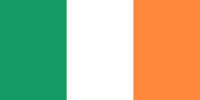Young Irelanders
|
Young Ireland
|
|
|---|---|
 Young Irelanders received the Irish tricolour from French republicans while in Paris in 1848. |
|
| Founded | 1842 |
| Dissolved | 1849 |
| Preceded by | Repeal Association |
| Succeeded by | Irish Republican Brotherhood |
| Newspaper | The Nation |
| Ideology |
Irish republicanism Irish nationalism |
| National affiliation | Repeal Association (1842–1847) Irish Confederation (1847–1848) |
| Colours | Green, White & Orange |
| Slogan | A Nation Once Again |
Young Ireland (Irish: Éire Óg, IPA: [ˈeːɾʲə ˈoːɡ]) was a political, cultural and social movement of the mid-19th century. It began as a tendency within Daniel O'Connell's Repeal Association, associated with The Nation newspaper, but eventually split to found the Irish Confederation in 1847. Young Ireland led changes in Irish nationalism, including an abortive rebellion known as the Young Irelander Rebellion of 1848. Many of the rebellion's leaders were tried for sedition and sentenced to penal transportation to Van Diemen's Land. From its beginnings in the late 1830s, Young Ireland grew in influence and inspired following generations of Irish nationalists. Some of the junior members of the movement went on to found the Irish Republican Brotherhood.
The name Young Ireland was originally used in a disparaging way to describe the group of young Repeal Association members who were associated with The Nation newspaper. At the time, the Repeal Association was campaigning for the repeal of the Act of Union 1800 between the kingdoms of Great Britain and Ireland. The term was first coined by the "English" press, and later used by leader Daniel O'Connell in a vindictive attack at Conciliation Hall, home of the Repeal Association.
...
Wikipedia
